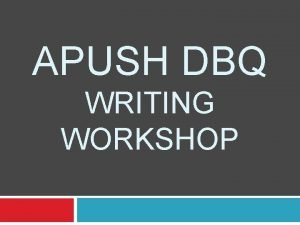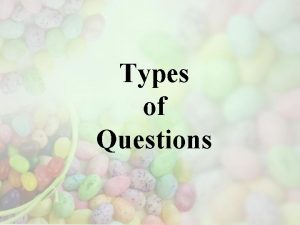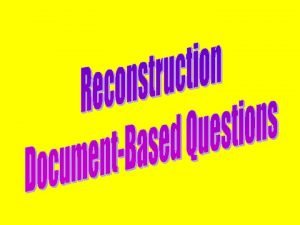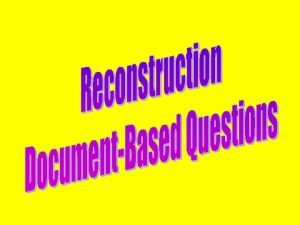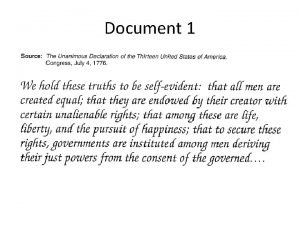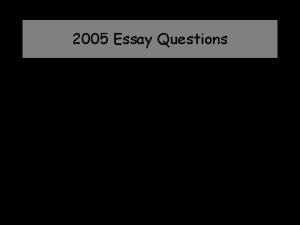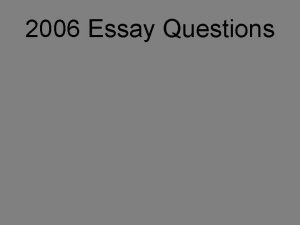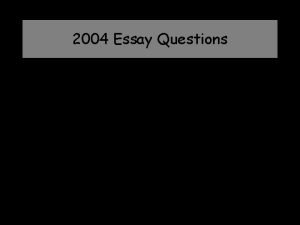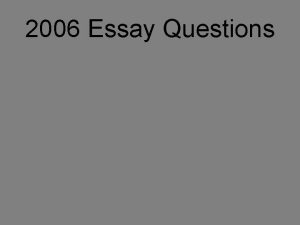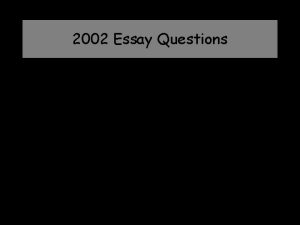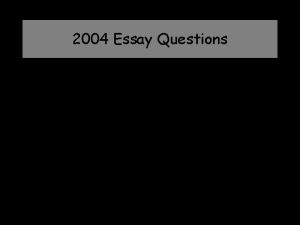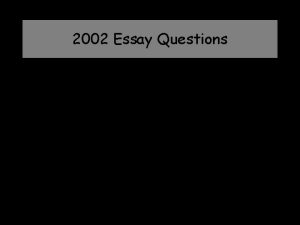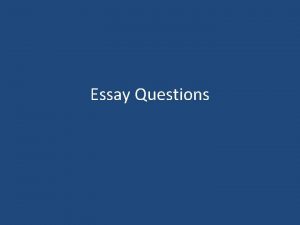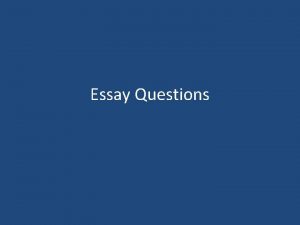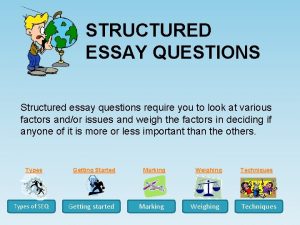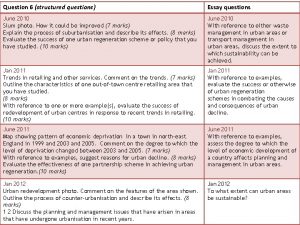The Essay Question Types of Essay Questions Document




















- Slides: 20

The Essay Question

Types of Essay Questions • Document Based Question (DBQ) – Based on eight to ten primary sources plus outside knowledge • Free – Response Question (FRQ) – Four questions = Two pre-1870 (select one) = Two Post 1870 (select one)

What Are the AP Essay Graders Looking For? • • • Answer the question Begin with a strong thesis Follow a reasonable outline The less confusing the better for the reader Be straightforward Readers are experts in history (don’t try to fool them)

What Are the AP Essay Graders Looking For? • Focus on the question • Make sure you answer the question being asked • More that just facts – although important • Reveal an understanding of the general principles – good analysis • Big picture of American History

What Are the AP Essay Graders Looking For? • Weave and understanding of content with analysis • Originality of thought • Interpretative history

What Are the AP Essay Graders Looking For? Summed Up • Express good ideas • Present valid evidence to support those ideas • Strong developed thesis • Quality of historical argument • Each essay is only read for about two minutes

Things That Make Any Essay Better Two Components 1. Plan what your are going to write 2. Use effective writing techniques = Better organized = Better thought out = Better written

Before You Start Writing • Read the question carefully • Brainstorm for a couple of minutes • Write facts, concepts and/or ideas that come to mind • Decide on your thesis (point of argument) • Organize information to fit thesis

Before You Start Writing • Aim for five paragraphs (although not an absolute) • Paragraph 1: Introduction – Thesis – Summary of three basic argument • Paragraphs 2 – 4: Body – Three arguments that support thesis – Historical evidence • Paragraph 5: Conclusion – Conclusion and wrap up – Restate thesis

Types of Arguments • • Three Good Points The Chronological Argument Similarities and Differences The “Watchdog” Argument

Arguments Continued Organize essay • First paragraph – addresses the question and states how you are going to answer it (Thesis) • Paragraphs 2, 3, and 4 – organized around a single argument by evidence thesis • Paragraph 5 – Ties the essay into a neat package. Answer the question here!!!

Writing Guidelines • Keep sentences as simple as possible • Throw in a few big words but don’t over do it • Write clearly and neatly • Define your terms • Use transitions words to show where you are going

Writing Guidelines Continued • Use structural indicators to organize your paragraphs • Stick to you outline • Try to prove one big picture idea per paragraph • Evidence, evidence • Make sure the first and last paragraphs directly answer the question

Summary • Answer the entire question • Brainstorm, choose a thesis, develop an outline • Follow your outline • One important idea per paragraph • Evidence, Evidence • Write clearly, neatly and to the point

Three Good Points • • Simplest strategy From brainstorming select three best points Each point the subject of a paragraph Save strongest point for last Topic sentence – then support Opening paragraph – what you intend to argue Final paragraph – what you have proven

The Chronological Argument • Certain questions lend themselves to this • Transitions between paragraphs essential • Paragraph two leads to paragraph three which leads to paragraph four • Opening paragraph sets the path • Closing paragraph restate essay question and answer it

Similarities and Differences I • • Comparison questions Start by setting a historical scene Each paragraph building an issue Last paragraph comparing and contrasting issues

Similarities and Differences II • Question my provide options • Comparing political philosophies of two presidents • Thesis states the essential differences between their philosophies • One paragraph to each philosophy • Fourth paragraph – major differences and similarities • Final paragraph – draw conclusions

Similarities and Differences III • Start with a thesis • Discuss three pertinent issues – Each president’s view • Final paragraph – overview of your argument

The “Watchdog” Argument • • Choose arguments opposite of yours State their arguments, then tear them down You do not have to prove you are correct Paragraph 2 - Summarize your opponent’s arguments in • Paragraph 3 – Search and destroy their arguments • Paragraph 4 – your argument • Showing both sides demonstrates you understand history is complex
 Is costa
Is costa Javascript document.write(document.cookie)
Javascript document.write(document.cookie) Types of essay question
Types of essay question Document based question
Document based question Question without question words
Question without question words Closed question and open question
Closed question and open question Contoh open question dan close question
Contoh open question dan close question Example of factor relating question
Example of factor relating question Direct question vs indirect question
Direct question vs indirect question Compelling questions
Compelling questions A compelling question
A compelling question Hình ảnh bộ gõ cơ thể búng tay
Hình ảnh bộ gõ cơ thể búng tay Bổ thể
Bổ thể Tỉ lệ cơ thể trẻ em
Tỉ lệ cơ thể trẻ em Gấu đi như thế nào
Gấu đi như thế nào Chụp tư thế worms-breton
Chụp tư thế worms-breton Chúa yêu trần thế
Chúa yêu trần thế Các môn thể thao bắt đầu bằng tiếng bóng
Các môn thể thao bắt đầu bằng tiếng bóng Thế nào là hệ số cao nhất
Thế nào là hệ số cao nhất Các châu lục và đại dương trên thế giới
Các châu lục và đại dương trên thế giới



